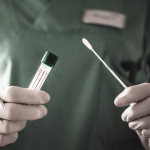Anal Pap smears are similar to cervical Pap smears in their ability to detect precancerous cells, according to a study published online January 6 in AIDS, and they appear to work better in people with HIV whose CD4 counts are below 400, compared with those with higher CD4s. However, anal Paps are not as effective at finding precancerous cells as an expert visual examination of the anus and rectum through a scope.
Anal cancer is on the rise in people living with HIV. Anal cancer also occurs at higher rates among people with HIV than among HIV-negative people, even when HIV-positive people have high CD4 cells.
The optimal screening method for anal cancer has not been investigated as thoroughly as screening for cervical cancer. Regular Pap smears have been thoroughly studied for cervical cancer screening and are recommended—along with further investigation if abnormal cells are found. Anal Pap smears, on the other hand, have been studied less thoroughly, even though regular anal Pap screening is recommended for HIV-positive men and women.
To determine the efficacy of anal Pap smears to detect abnormal cells, Mayura Nathan, MD, from the Homerton University Hospital NHS Foundation Trust in London, and her colleagues performed anal Pap smears on 367 men and 28 women. All of the participants had been referred to Nathan’s clinic for further examination because it was suspected they had anal disease.
Of those, 212 were HIV positive, and 156 were HIV negative. Roughly half of the participants were white, and about 75 percent were men who have sex with men (MSM). Nathan’s team compared anal Pap smears followed by visual examination using a scope inserted into the anus (anoscopy) after the tissue had been stained with iodine. Suspect tissue was then biopsied.
Pap smears detected precancerous cells about 70 percent of the time. They were accurate about 71 percent of the time in MSM and 58 percent of the time in heterosexual participants in general, but they were higher when the degree of precancerous abnormality was more severe. Anal Paps were also more effective when there were more precancerous cells. The authors state these rates of anal Pap smear sensitivity are comparable to those of cervical Pap smears.
Anal paps were more likely to pick up abnormal cells in people with HIV than in their HIV-negative counterparts. Based on anoscopy, the likelihood of having more severe cell abnormalities was significantly higher in HIV-positive participants than HIV-negative participants. The sensitivity of anal Paps to detect precancerous cells was greater in HIV-positive participants with CD4 cells under 400 than in people with CD4s over 400.
“Given the inaccuracies that exist with any method of evaluation, we need to have a number of…methods for the diagnosis of anal [cell abnormalities],” the authors conclude. “This study supports the introduction of an earlier screening in HIV-positive patients…. Additionally, we demonstrate the use of anal [Paps] after treatment of anal neoplasia for screening for recurrent disease.”
Advertisement
Advertisement
Advertisement






3 Comments
3 Comments